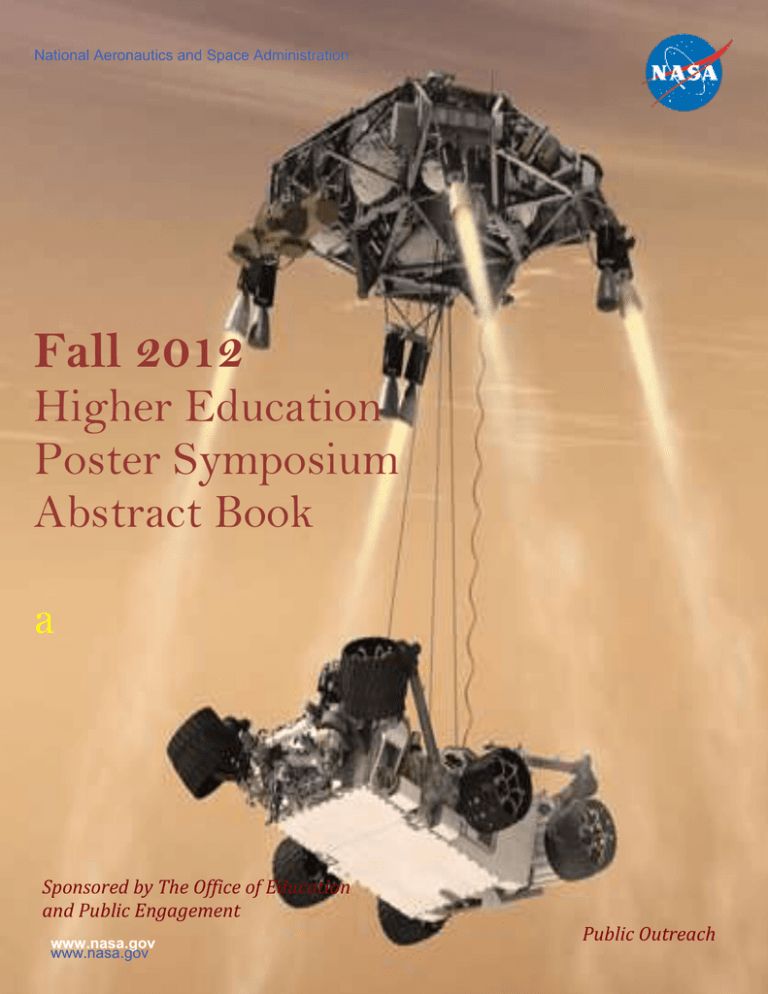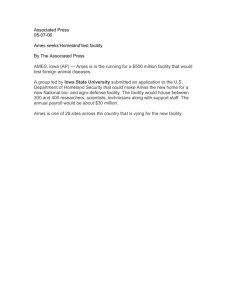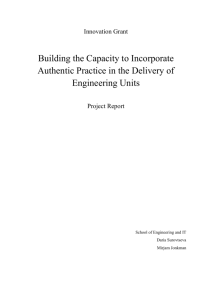Fall 2012 Abstract.Book
advertisement

National Aeronautics and Space Administration Fall 2012 Higher Education Poster Symposium Abstract Book a Sponsored by The Office of Education and Public Engagement www.nasa.gov www.nasa.gov Public Outreach The Office of Education and Public Outreach is proud to share these abstracts from the undergraduate interns at NASA Ames Research Center. During their time at Ames, these students have greatly contributed to the NASA mission through their research and mission support activities. The interns and fellows greatly enriched the Ames community and we look forward to welcoming these participants into our workforce in the future. A special thanks to the Ames community; we greatly appreciate the Ames staff in helping us develop the next STEM workforce. Brenda Collins Higher Education Program Manager NASA Ames Research Center Fall 2012 Cohort Programs USRP: The NASA Undergraduate Student Research Project (USRP) offers year-round internship opportunities for undergraduate science, math, and engineering students. USRP is funded by the NASA Headquarters Office of Education. Space Grant: NASA initiated the National Space Grant College And Fellowship Program in 1989. Space Grant is a national network of colleges and universities. These institutions are working to expand opportunities for Americas to understand and participate in NASA’s aeronautics and space projects by supporting and enhancing science and engineering education, research and public outreach efforts. Ames USRP Project Manager: Maricela Varma, AERO Institute Ames Education Staff: Sylvia Love and Mary Schaadt, AERO Institute Table of Contents Fall 2012 Poster Symposium Participants Individual Projects Name Page Connor Beierle 1 Large Civil Tiltrotor (LCTR) & High Efficiency Tiltrotor (HETR) 7x10 Foot Subsonic Wind Tunnel Test, Stony Brook University, USRP, William Warmbrodt, Ashley Pete, Colin Theodore Corbin Graham 2 Design and Development of an Educational Outreach Wind Tunnel with a Tilt Rotor Aircraft Model, University of Oklahoma, EAP, William Warmbrodt Michael Lee 3 Lyophilization as a Means of Preserving Microorganisms for Satellite Missions, Kean University, USRP, Brad Bebout Matthew Menze 4 Modeling of Tensegrity Structures for Research into Alternative Robotic Locomotion, Northern Michigan University, USRP, Vytas Sunspiral Jose Ortiz 5 Design and Analysis of Microphone Stands for the 40-by 80-Foot Wind Tunnel University of Puerto Rico, Space Grant, William Warmbrodt, Ashley Pete, Ben W. Sim Ames Research Center Your Photo Here Fall 2012 Connor Beierle, Stony Brook University Undergraduate Student Research Program (USRP) Undergraduate Intern Mentor: William Warmbrodt Ashley Pete C olin Theodore Code: AUA Aeromechanics Branch Large Civil Tiltrotor (LCTR) & High Efficiency Tiltrotor (HETR) 7x10 Foot Subsonic Wind Tunnel Test The congestion associated with runway availability hinders an airport’s ability to increase its number of departures and landings. A viable solution to both military and civilian air travel is with tiltrotor technology. In order to justify an investment in the manufacturing of a tiltrotor, scale tests of conceptual designs must be performed in wind tunnels. The High Efficiency Tilitrotor (HETR) and the Large Civil Tiltrotor (LCTR) are two scale models which were tested in the 7x10 Subsonic Wind Tunnel to acquire airframe performance data and validate the integration of tiltrotor aircraft into our air transportation system. The accuracy associated with a wind tunnel’s scale system directly influences the quality of the acquired data. For wind tunnel data analysis, great care must be taken to remove the components of the scale readings associated with the model’s shifting center of gravity and from the aerodynamic influence of the support configuration in the recorded wind tunnel scale data. The research discussed in this paper discusses the methodology on how to optimize the data acquisition process to strengthen one’s mathematical model and produce high quality results. The derivation of the weight and aero tares are justified and then applied to produce processed data. Coordinate transformations are additionally derived to analyze the model from the wind or aircraft’s perspective. Lastly, processed experimental data is non-dimensionalized to analyze intrinsic characteristics of the aircraft in design, independent of wind tunnel model scale. The results of these experiments are necessary milestones contributing to the tiltrotor development and integration process on a global scale. Ames Research Center Your Photo Here Fall 2012 Corbin Graham University of Oklahoma Oklahoma Space Grant / Education Associates Program (EAP) Undergraduate Intern Mentor: William Warmbrodt Code: AUA Aeromechanics Branch Design and Development of an Educational Outreach Wind Tunnel with a Tilt Rotor Aircraft Model Wind tunnels provide crucial data to scientists and engineers. They can also aid in attracting and retaining students in STEM disciplines. The goal of this project is to develop a wind tunnel that can be transported easily to locations for STEM outreach and spark interest in students. The first step in this project is to design a functional wind tunnel using calculations and developing a 3-D model using the Rhinoceros software program.. The next steps include obtaining the correct parts and equipment to construct the wind tunnel. A small-tilt rotor aircraft will also be designed and placed inside the wind tunnel for visual aid. The small-scale tilt rotor will be designed in Rhinoceros and certain parts will be printed on the Dimension Elite 3-D printer. The small-scale tilt rotor will also be modeled in a computational fluid dynamics software, ROTCFD, and analyzed before being installed in the Outreach Wind Tunnel. Lastly a measurement system will be implemented in the tunnel to measure air speed and pressure in the wind tunnel test section to quantify results and processes. Ames Research Center Your Photo Here Fall 2012 Michael Lee, Kean University Undergraduate Student Research Program (USRP) Undergraduate Intern Mentor: Brad Bebout Code: SSX Exobiology Lyophilization as a Means of Preserving Microorganisms for Satellite Missions With future manned-spaceflight missions aimed beyond low-Earth orbit (i.e. the moon, Mars, and asteroids), investigating the effects of cosmic and solar radiation is becoming increasingly important. Microorganisms such as algae and bacteria are convenient test subjects for biological research in orbiting spacecraft due to their low weight/cost and range of metabolic activity. Furthermore, the self-sustaining environmental control and life support systems required for longer duration manned-missions will likely include microbial ecosystems as a means of carbon cycling and oxygen production and this demands a better understanding of the capabilities of these systems’ potential applications in space exploration. For these reasons, photosynthetic microorganisms are being suggested for study in nanosatellites and other orbiting missions. This work investigates lyophilization as a means of maintaining microorganisms in a period of stasis without the need to store them in extremely cold temperatures. Various methods of preliminary cryopreservation were attempted combined with different post-lyophilization protocols in the hopes of identifying a procedure that will reliably maintain organism viability. Ames Research Center Your Photo Here Fall 2012 Jose Ortiz University of Puerto Rico - Mayagüez Puerto Rico Space Grant Consortium Undergraduate Intern Mentor: Ashley Pete Be n W. Sim William Warmbrodt Code: AUA Aeromechanics Branch Design and Analysis of Microphone Stands for the 40-by 80Foot Wind Tunnel Collecting sound data in the 40- by 80- Foot Wind Tunnel at 260 knots is a task that interests the U.S. Army and the National Aeronautics and Space Administration (NASA). Military helicopters must be designed and tested to demonstrate low noise and mission survivability. The Federal Aviation Administration (FAA) has regulated the sound levels that an aircraft can generate. New aircraft are held to tighter noise standards. The Acoustic Sound Apparatus (ASA) was originally designed to obtain three-dimensional data in the wind tunnel, but it can only withstand winds up to 200 knots and was modified without documentation. A vertical microphone array in a transverse rail is being designed with some of the ASA parts. The purpose will be to gather noise data in front of the helicopter rotor without disturbing the flow of the wind. Furthermore, this system is to be removable for tests that do not require it. ProE/Creo is being used to analyze the integrity of the microphone stand structure using 300-knot aerodynamic forces to ensure adequate design.






